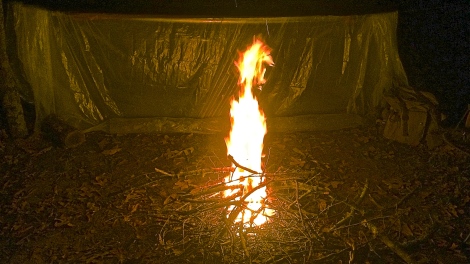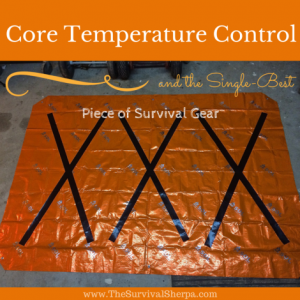Mother Nature is always true to her nature. You can’t change her. She’s beautifully rugged, awe-inspiring, and occasionally deadly. Best be prepared when she tries to make your life miserable.
Like duct tape and WD-40 in my tool box, there aren’t many Core Temperature Control dilemmas my reusable emergency space blanket can’t fix. This may be the best 12 ounces you can add to your hunting, hiking, camping, fishing, and/or 72 hour emergency kit.
Mors Kochanski of Karamat Wilderness Ways, the Godfather of modern bushcraft, came up with a brilliant idea called The Super Shelter. His design takes advantage of radiant heat from fire and a layer of clear plastic sheeting to help you survive extremely cold conditions.
Building The Super Shelter microclimate has been on my Doing the Stuff to-do list for a while now. Finally got some cold weather so decided to give it a test. Our midweek forecast is calling for a single digit windchill factor. A great time to put theory to the test.
The Modified Super Shelter
This design is a modification of the 5 Minute Emergency Shelter taught at The Pathfinder School. Here’s what you’ll need to construct your own…
- 5 x 7 foot reusable emergency space blanket
- 4 tent stakes
- Clear plastic sheeting – cheap painter’s drop clothes run around $3.50
- 25 feet of cordage
- Ground insulation – 4 to 6 inches of compressed natural material or ground mat to battle conduction
- Firewood – lots of it!
First, set up a lean-to shelter with your emergency blanket. I won’t rehash this part. For more info on this set up, click here. Lay the clear plastic over the lean-to and secure to the two back tent stakes. Nothing fancy. I simply tied each corner to the stakes. Use cordage if you’d like.

Starting my fire with duct tape
Use a 6 to 7 foot long log/stick to secure the front flap over the opening of the lean-to. Roll the stick into about a foot of the front flap until the plastic is plumb under your ridge line. This secures the flap and allows a quick escape in case you need to attend to an emergency during the night. If the stick is not too large, you could simple lift it to add fuel to the fire without leaving the shelter.
The Test
I kissed Dirt Road Girl goodnight around 9 PM, went out to my backyard bushcraft area and took a temperature reading inside the shelter… a brisk 24º F. For my northern friends, this may be shorts and sleeve weather, but in Georgia, that’s nippy. By morning, the mercury read 19º.
I advocate trading theory for ACTION. Doing the Stuff in a controlled environment (my backyard) with untested gear and designs prepares me before I actually need the skill or kit item for survival.
Gotta Have Fire
Onto the test. There’s no such thing as “cheating” when it comes to fire in a survival scenario. Start a sustainable fire any way you can. I used a few feet of Gorilla tape and my Bic lighter to ignite my smalls and burn my fuel-size wood.
For this survival shelter, be sure to collect enough firewood to last you through the night. How much do you need? More than you just collected. A pile of dead wood the size of your shelter may get you through a freezing evening.

Ideally, you’d want a fire burning the length of The Super Shelter (6 to 7 feet). For this test, my fire was only 2 feet in length. Even with this short fire, the temps inside the shelter grew to 62 degrees in less than 10 minutes. A long fire will have you “smoothing it” in your skivvies! Yep, no photo documentation of that epic event last night.
Clothing and Cover
Outside your first element of cover (clothing), your lightweight, multifunctional space blanket is one of the best pieces of survival kit you can carry in the woods. If you’ve dressed properly for the weather, your clothing is all you’ll need to stay warm in The Super Shelter.
My layered clothing consisted of what I’d normally wear on a camping, hunting, or bushcraft outing in cold weather.
- Synthetic base layer top
- Long sleeve under shirt
- Long sleeve button shirt
- Carhartt pants (medium-weight) – no synthetic base layer tonight since I was in my backyard
- Sock liners and one pair of wool shocks (medium weight)
- Pull-on leather boots
- Homemade wool hunting shirt from an Italian Army blanket
- Wool Sherpa hat
Lying in the shelter for 20 minutes, I began to peel layers… wool hat first. My hunting shirt became my pillow for my uncovered head. My biggest concern was my feet as they extended past my ground mat. Not an issue. My toes were toasty warm the entire 4 hour test.

Why not the entire night? Remember what I said about firewood? I burned all my firewood and the shelter loses heat quickly without a radiant fire. Note to self… Get. More. Wood!
Conclusions
Keep in mind that this is not a long-term shelter. But for a 72-hour emergency, it is superb for Core Temperature Control. By the way, I discovered that a 9′ x 12′ foot painter’s tarp would have been enough to create this shelter. I went with a 20′ x 25′ to be sure.
Even for a half night stay, the modified Super Shelter design is totally worth packing two extra pounds for extreme cold weather outings!
Keep Doing the Stuff of Self-Reliance,
Todd

